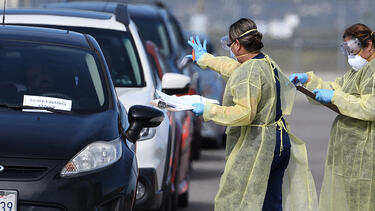Faculty Viewpoints: The Public Health Response
In an online discussion, Yale faculty members discussed what’s missing from the public health response to COVID-19 and offered visions of the post-pandemic world.

Drive-through testing for COVID-19 in Lake Elsinore, California, in March 2020. Photo: Bob Riha, Jr./Getty Images.
By Dylan Walsh
On March 6, President Trump signed into law a bill providing $3 billion for the development of vaccines, therapeutics, and tests that target the coronavirus that causes COVID-19. Three weeks later, he signed another law that dwarfed its predecessor, providing $2.2 trillion of support to U.S. businesses.
In a conversation at Yale SOM last week, Jason Abaluck, associate professor of economics, offered a historical analogy for this use of resources. Imagine that during the Blitz, Winston Churchill went on the radio…to pledge financial support for struggling British restaurants and tailors and banks.
“While that support is immensely useful and should be there, there’s a huge thing he’s missing,” Abaluck said—the war with Nazi Germany. “They are by far the overwhelming policy priority, and today we are in basically the same situation.” When the U.S. and other countries think about their policy response to the coronavirus, Abaluck said, they should focus first, not on what steps are needed to open the economy, but on what must be done to stop the spread of the virus.
Abaluck appeared in the first of a series of online faculty conversations exploring various aspects of the COVID-19 crisis. The discussion, focusing on public health, also included Edward Kaplan, the William N. and Marie A. Beach Professor of Operations Research, professor of public health, and professor of engineering, and James Hamblin, a staff writer at the Atlantic who lectures at the Yale School of Medicine and the Yale School of Public Health. Dr. Howard Forman, a professor in the practice of management at Yale SOM, who also holds appointments at the School of Medicine and the School of Public Health, was the moderator.
Kaplan for the past several weeks has been working with the State of Connecticut to determine needed steps to stop the spread of the virus. He has concluded, he said, that the most feasible and efficient response would be to unroll a massive screening regimen and isolate those who test positive. Infected people with room at home could quarantine there; those with tighter living quarters, or who are homeless, need to be provided a place to quarantine, like a hotel room, for 14 days.
“The models show that if, for example, you could isolate 80% of the population right around the time they are having symptoms, or even earlier, that would be enough to put you below the epidemic threshold,” Kaplan said. “That could actually make the whole thing disappear.”
The logistics to make this happen, though, will not be easy. Kaplan suggested the U.S. will need to be testing millions of people per day, both making kits available to people with very mild symptoms and proactively reaching out to communities at large. He suggested setting up temporary testing at gas stations, grocery stores, and other public hubs, as a way to capture somewhat representative samples of infection rates across the country.
Leaders in the private sector should simultaneously be thinking about ways to re-engineer their workplaces to suit today’s restrictive climate. “The idea that somehow or another you can soon just let people go back to work is misleading,” Kaplan says. What we will see instead is a careful, monitored, and incremental reopening that will require companies to adapt. Higher education, for instance, has been moving, with decent success, online. And while Ford employees can’t build a car from their homes, Kaplan proposed that manufacturers can take steps to safeguard their lines against infectious disease; for example, teams would get screened before going to work and then cycle into the plant for two-week periods. Yes, it would be difficult for workers and their families, and less efficient, but it’s doable. “Everyone who is sitting at home should be thinking creatively about how we can do some of these critical functions in ways that are safe,” he said. “It’s not impossible. It just requires a bit of imagination.”
Asked by Forman how this pandemic might reshape our society, Hamblin pointed out how the healthcare crisis “is putting a lens to all the issues that already existed in society.” Jails and homeless shelters, where people are already disproportionately burdened by disease, are getting hit extremely hard, as are poor workers and communities. Perhaps, he said, in the aftermath we will take time “to re-conceptualize how health and the economy are interwoven,” he said.
Abaluck highlighted the way in which so much of life has moved online, from telemedicine to academic conferences and business meetings. “We needed a shock to make this migration happen,” and he suspects what we see today will persist.
Kaplan offered the hope that we’ll come out of this experience with a less reactive, and more “button-ready” public health infrastructure: when various crises pop up, we should be able to activate existing systems to address them. “So much of what’s happening now is that people find themselves knowing what they’d like to do but not having the resources to do it,” he said. “If there’s a lesson to be learned here, I’d like to think that people should really take more seriously these planning exercises where we think about the threats to public health. I’m not suggesting we’re going to be invaded by Mars, but we need to build up these capacities.”
Watch the discussion: